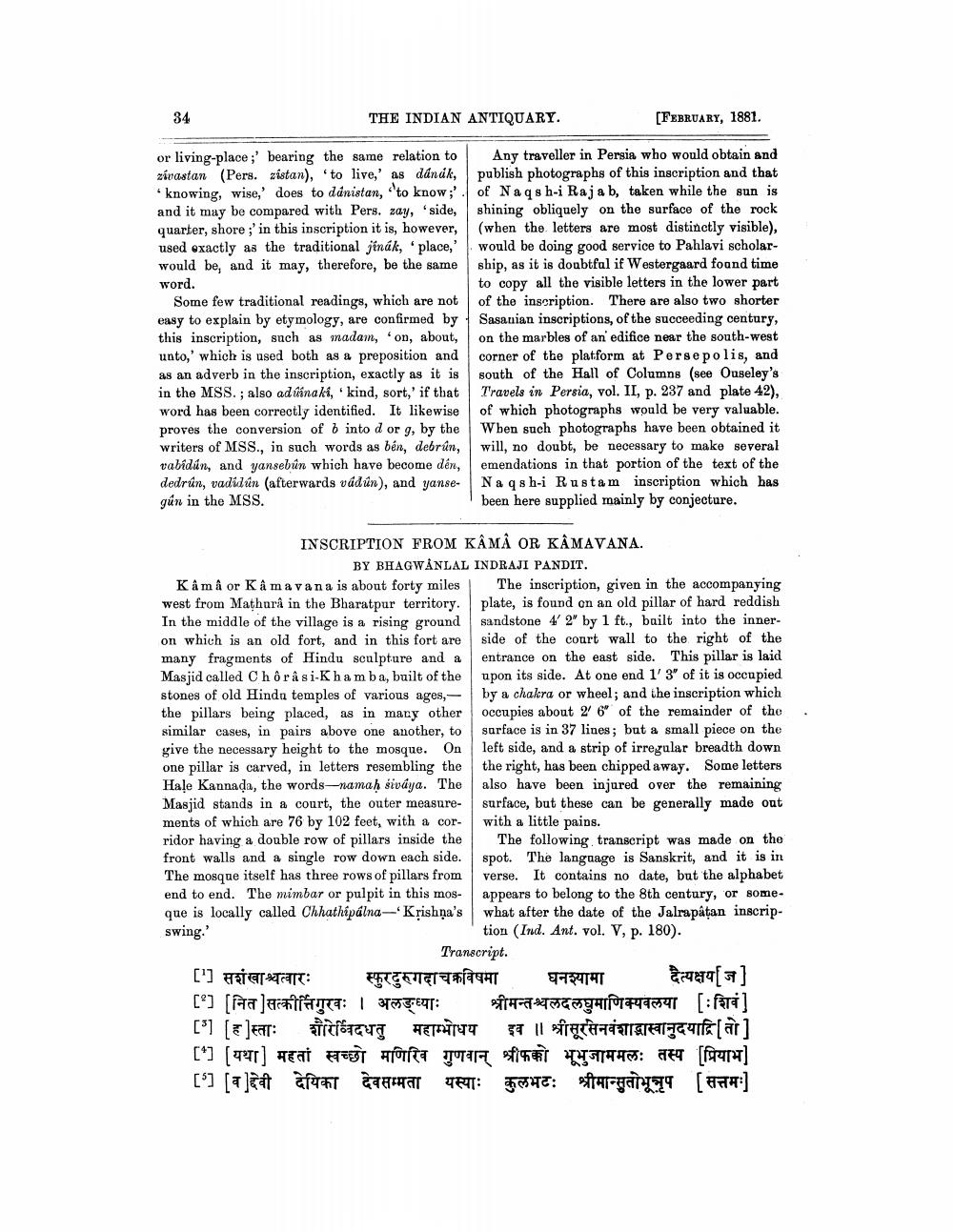________________
THE INDIAN ANTIQUARY.
[FEBRUARY, 1881.
or living-place;' bearing the same relation to Any traveller in Persia who would obtain and zívastan (Pers.zistan), to live,' as dának, publish photographs of this inscription and that “knowing, wise,' does to danistan, to know;' . of Naqsh-i Rajab, taken while the sun is and it may be compared with Pers. zay, 'side, shining obliquely on the surface of the rock quarter, shore ;' in this inscription it is, however, (when the letters are most distinctly visible), used exactly as the traditional jinák, place,' would be doing good service to Pahlavi scholarwould be, and it may, therefore, be the same ship, as it is doubtful if Westergaard found time word.
to copy all the visible letters in the lower part Some few traditional readings, which are not of the inscription. There are also two shorter easy to explain by etymology, are confirmed by 1 Sasanian inscriptions of the succeeding century, this inscription, such as madam, on, about, on the marbles of an edifice near the south-west unto,' which is used both as a preposition and corner of the platform at Persepolis, and as an adverb in the inscription, exactly as it is south of the Hall of Columns (see Ouseley's in the MSS.; also ad finaki, kind, sort,' if that Travels in Persia, vol. II, p. 237 and plate 42), word has been correctly identified. It likewise of which photographs would be very valuable. proves the conversion of b into d or g, by the When such photographs have been obtained it writers of MSS., in such words as bén, debrún, will, no doubt, be necessary to make several rabidin, and yansebûn which have become den, emendations in that portion of the text of the dedrún, vadiún (afterwards vádún), and yanse- Naqsh-i Rustam inscription which has gún in the MSS.
been here supplied mainly by conjecture.
INSCRIPTION FROM KÂMÅ OR KÂMAVANA.
BY BHAGWÅNLAL INDRAJI PANDIT. K â mâ or Kamavana is about forty miles The inscription, given in the accompanying west from Mathura in the Bharatpur territory. plate, is found on an old pillar of hard reddish In the middle of the village is a rising ground sandstone 4' 2" by 1 ft., built into the inneron which is an old fort, and in this fort are side of the court wall to the right of the many fragments of Hindu sculpture and a entrance on the east side. This pillar is laid Masjid called Chôr å si-Khamba, built of the upon its side. At one end 1' 3" of it is occupied stones of old Hindu temples of various ages, by a chakra or wheel; and the inscription which the pillars being placed, as in many other occupies about 26" of the remainder of the similar cases, in pairs above one another, to sarface is in 37 lines; but a small piece on the give the necessary height to the mosque. On left side, and a strip of irregular breadth down one pillar is carved, in letters resembling the the right, has been chipped away. Some letters Hale Kannada, the words-namah siváya. The also have been injured over the remaining Masjid stands in a court, the outer measure- surface, but these can be generally made out ments of which are 76 by 102 feet, with a cor- with a little pains. ridor having a double row of pillars inside the The following transcript was made on the front walls and a single row down each side. spot. The language is Sanskrit, and it is in The mosque itself has three rows of pillars from verse. It contains no date, but the alphabet end to end. The mimbar or pulpit in this mos- appears to belong to the 8th century, or someque is locally called Chhathipálna-Krishna's what after the date of the Jalrapatan inscripswing.'
tion (Ind. Ant. vol. V, p. 180).
Transcript. ['] सशंखाश्चत्वारः स्फुरदुरुगदाचक्रविषमा घनश्यामा दैत्यक्षय[ज] [e] [Fara juriffraca: | 37457ETT:
CETATOTT0541 [: fata] [] []eaT: TT&TTUI HETIHTTU 5Tll sfracada u [ar] [*] [ ] Hat OT HITTA TSF
: DET [99] [S] [a]# aforam a ma TFIT: HT: turgan [HTA:)




